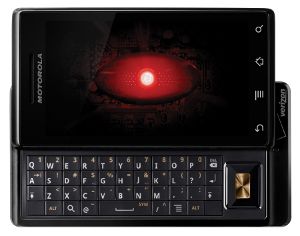
Up to now, if you wanted a smartphone with power and without complexity, the only orchard you could go to was Apple’s. With the arrival of the Motorola Droid, though, that’s changed.
The Droid uses Google’s Android operating system. It’s not as slick as the OS in Apple’s iPhone, but it’s still a breeze to use, and it has some tricks of its own, like voice search. Yes, you can talk to this phone, and it will fill in your search terms. It’s accurate, too. As a goof, I asked it to find “chronosynclastic infundibulum,” and performed the search without a sneeze.
The unit will also run more than one application at a time. That’s useful when you’re using it as a GPS navigation device and a phone.
Tight Jeans
If you like wearing tight jeans and carrying your cellphone in your pocket, the Droid may not be for you. At half an inch thick, it’s chunkier than something like the iPhone and at six ounces, noticeably heavier.
It has a gorgeous, expansive display. Measuring 3.7 inches diagonally, the TFT capacitive touchscreen supports 16 million colors and has a resolution of 480 by 854 pixels. Even the smallest fonts on Web pages are legible on the display, and multimedia objects — photos and videos — are sharply rendered. It responds snappily when poked.
Items can selected by touching them on the screen. To drag an object on the monitor, you touch it and drag it around. You can rapidly scroll up and down or left and right on pages by flicking your finger on the display. Although the screen doesn’t support “pinching,” you can increase the size of a Web page or photo on the display by double tapping it.
Smart Searching
In the vertical orientation — the screen content rotates between portrait and landscape depending on the orientation of the phone — there are four touch controls. They allow you to return to a previous screen, call up application menus, return to the home screen and do a soft search key. What kind of search is activated by the key is determined by what application is running on the phone. So if you’re at the home screen, the search key activates a Google Web search, but if you’re in the phone app, it will perform a contacts search.
In addition to a virtual keyboard, the Droid has a “thumbboard” that slides out from the side of the unit. The keypad’s keys are relatively flat and crowded. I found typing with my thumbs difficult. Finger typing was easier, but then I had to set down the phone on a flat surface to type, which wasn’t always convenient.
The keypad has a standard QWERTY layout. The numbers one to zero are located across the top row of keys and can be entered by pressing one of either of two ALT keys found at the bottom of the clavier.
5MP Camera
In addition to the QWERTY keys, the keypad has some special keys that add functionality to it. These are located in the same row as the spacebar. There’s a dedicated “@” key. That’s convenient for pecking in email and Twitter addresses. There’s a search key for finding information. There’s also a menu key and a Directional Key. The Directional Key allows you to navigate across the screen and select items without moving your fingers from the keypad.
On top of the unit is a button that does triple duty. It turns the device on or off, blanks the display or locks it. Beside the on/off button there’s also an earphone jack.
On the left side of the phone is a mini USB port that can be used for charging the unit and transferring data.
On the right side of the phone is a button for activating its built-in camera. You hold the button in until the camera screen appears. The camera, which has a 4x zoom, will capture images in either portrait or landscape mode at five megapixels, or a maximum resolution of 2,593 by 1,944 pixels. The camera’s lens and flash are located at the back of the unit.
The camera also shoots video with a resolution of 720 by 480 pixels at 24 frames per second and playback at 30 fps. Files formats supported are MPEG-4, H.263 and H.264.
Brisk Web Surfing
As high-powered as the Droid is, making a call with the phone is more intuitive than some less-endowed mobiles. From the home screen, you tap a phone icon. A traditional telephone keypad appears on the screen. You can punch in a number or poke an icon to access your phone log, contacts file or list of favorite numbers. To place the call, you simply touch a green handset icon at the bottom of the screen. What’s more, voicemail can be accessed with a single tap of an icon.
Web browsing was very brisk on Verizon’s 3G network. What’s more, the quality of streaming video from sites like YouTube compared favorably with the experience you’d get on a PC.
Like the iPhone, Google has an app store for its Android OS. Programs packaged with the Droid include Google Maps, Gmail, Calendar and Amazon’s MP3 storefront.
Verizon is offering the Droid for US$199.99 with a two-year service agreement and $100 mail-in rebate.
Google’s intuitive operating system coupled with some top-shelf Motorola hardware and Verizon’s spritely 3G network make the Droid an attractive package for mobile users who want a smartphone they don’t need a degree in geek to use.























































Except for the voice search and a 3.2 MP camera instead of 5, which meets my camera needs. It’s also smaller and has a better design too so it isn’t a monster that doesn’t fit in your pocket. No mention at all in your article about Palm or Blackberries though.. I guess all that exists in the world are Droids and iPhones.